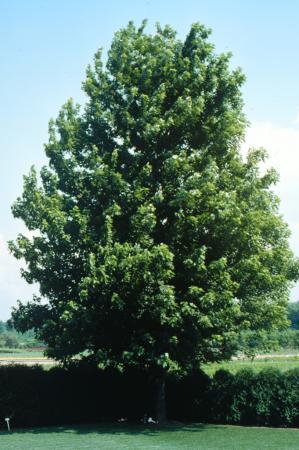June 27, 2013
| Acer xfreemanii Freeman Maple
|
| Description | Freeman maples are chosen for the wonderful fall colour usually found in a red maple, but with the added traits of hardiness and ease of growing often found in a hybrid. Choose cultivars based on the desired characteristics. |
| Usage | Buffer strip, swale, reclamation, shade tree, street tree. |
| Origin | Hybrids of Acer rubrum and Acer saccharinum naturally occurring and of nursery origin. |
| Hardiness zone | 4 |
| Size | 15-25m |
| Form/texture | Upright to broad oval, varies with cultivar. |
| Growth rate | Medium to fast. |
| Leaf | Opposite, simple, lobed; fall colour varies with cultivar. |
| Flower | Early spring, green to red. |
| Fruit | Samaras; seedless cultivars available. |
| Exposure/culture | Cultivars chosen for their improved tolerance to drought, hardiness, rate of growth, fall colour. Tolerates occasional wet to occasional dry soils. Easy to transplant. Few problems with pests (leafhoppers), diseases. 'Sienna', has been successful in Manitoba (Ronald). Seedless (or nearly so) cultivars include 'Jeffersred', 'Celzam', 'Marmo', 'Satzam'. |
| Comments | A. rubrum and A. saccharinum have long been known to freely hybridize both in the wild and in the nursery. Some hybrids were recognized as superior to either species. Oliver Freeman, working at the U.S. National Arboretum, produced a controlled cross in 1933, the progeny of which Edward Murray formalized by naming in 1969. The advantage of using Freeman's maple in urban areas is that they are much more tolerant of high pH soils than the commonly planted red maple, and, thus, are not as prone to succumbing to stresses induced by iron chlorosis. This hybrid also can display outstanding red fall colour, especially with some of the cultivars that have been developed. Overall, this is a fast-growing tree that isn't too fussy about site conditions, however, the fast growth often develops into poor structure, and untrained trees are prone to large limb failure, as with silver maple. Individuals can be compromised by the physiological drought brought upon by built-up road salt in the soil. There are so many variations in morphology in the hybrids and the parents, it can be challenging to know exactly which maple a tree may be. The hybrids are not always superior to the parents (Santamour). New cultivars are common, and trialing for the landscape will prove their worthiness. Choose cultivars based on the desired characteristics and enjoy.
|
Reference:
Ronald, Philip. 2006. The Hunt For Red September. http://www.jeffriesnurseries.com/hunt.htm
Santamour, F. 1993. Freeman Maple- Illusion and Truth. Journal of Arboriculture 19(4): 195-200.
